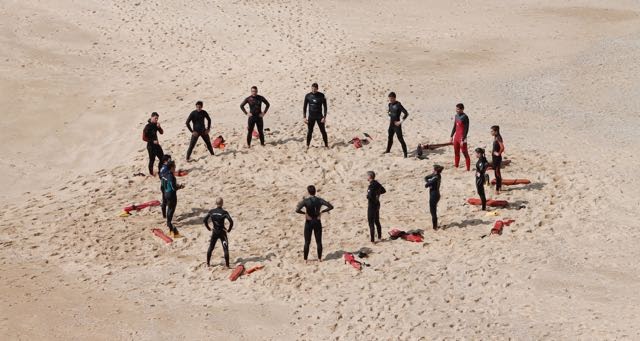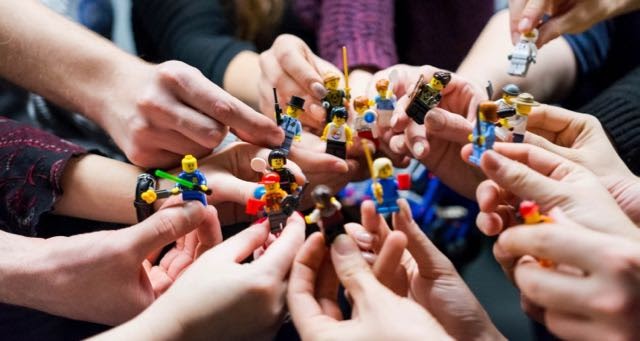
Listen to the universe
Listen! Your world is likely speaking to you daily. The daily obstacles you and your team face are the treasure trove of opportunities needed to streamline your operations improve your team culture. Indeed, the obstacles are the path, and distilling sustainable solutions out of them is the name of the game. What’s more, running a free market for ideas and solutions helps teams bond and can become your growth engine. This engine can drive your productivity and workplace culture.
What is team culture?
Culture is the soil. It is the nurture that we all need to reach our full potential. That is why we should actively seek to optimize it.
Team culture refers to the shared values, beliefs, attitudes, behaviors, and practices that shape the identity and character of a team. It is the collective personality of the team that reflects the way team members interact with each other, work together, communicate, solve problems, and make decisions.
A positive team culture fosters trust, respect, collaboration, innovation, and a sense of belonging among team members. It encourages open communication, constructive feedback, and continuous learning and development. A strong team culture helps to build a cohesive and effective team that can achieve its goals and objectives.
On the other hand, a negative team culture can lead to conflict, mistrust, dysfunction, and a lack of motivation and engagement among team members. It can undermine the team’s performance and hinder its ability to achieve its objectives. So it is important for teams to foster a positive team culture that supports the team’s mission and goals.
How to improve workplace culture?
What can we do to get better soil? Here we will attempt to summarize a set of objective truths and tangible tools and techniques that together come close to forming a scientific method, or at least an approximation of one, for creating an optimal work environment and ultimately boosting productivity.
Let’s dig in. Below we will develop themes within the framework of five very tangible and actionable categories.
- Slow down & be deliberate
- Create regular structured gatherings
- Look for what works and duplicate
- Create opportunities for interaction
- Bring tangible environmental improvements
Two guardrails to keep in mind while shaping your company culture:
- Begin with the end in mind – Imagine you are at your retirement party and a few people are about to take turns on the stage and speak about you. What would you like them to say? Everything you do should be governed by what you’d like the team you leave behind to say about you, long after you are gone.
- See beyond yourself – Always expand your perspectives. Govern the environment but let a free market of ideas and experiments find its own equilibrium and optimal solutions. This alone can transform corporate culture.
Remember that everything we do lives on the Speed & Quality spectrum. Speed and quality are the two extremes. As a rule of thumb, while speed has its please, I like to think that most things we do should fall closer to quality rather than speed. So when in doubt, slow down. Rome was not built in a day. Office culture is very much like Rome – it has many layers.
Slow down & be deliberate

Photo by Glenn Carstens-Peters on Unsplash
Let information flow freely, both ways
Bring everyone in on the big picture whether you are selling ice cream or making the internet a better place. Take the time to show your team the condensed data that you put together and show to your superiors.
This does two things that are a fundamental layer for organizational culture:
- It unites people around a common goal that is tangible and easy to understand. Think of a north star metric. It could be orders per month or average fulfillment time. You can show how all the seemingly small process changes benefit the average fulfillment time. Or result in getting more organic orders.
- Also, transparency helps your team understand what you do in all these meetings and why the hell you are so busy all the time. In turn, understanding your day to day helps people better define their career paths and goals. What’s more, you will be able to better guide people to grow in a direction that suits them best.
Guide by sitting midway between directing and following
The moment you start thinking you have arrived at the optimal perspective, you start stagnating. Keep seeking and let your team seek.
- Be a governor, not a traffic cop – Stay informed, guide, and only use your power to veto when you really need to. Let people find their own legs by making mistakes and recovering, when possible.
- Tap the hive mind and build autonomy – Let your team’s collective perspective and ideas drive change and solve issues. Think about how much time you will get back if you trust your team to solve things themselves.
- Distribute responsibilities – Focus is, arguably, the single most powerful driver of productivity. So sometimes it’s best to cut down on projects so things can move along optimally. Try it! If you are working on ten projects, delegate half to five different people. You will get time back and learn more about your team.
- Find your pace – Your pace dictates the pace of your entire team and that affects where you fall on the Speed & Quality spectrum. Often the more balanced you are on the Direct & Follow spectrum, the quicker you arrive at optimal solutions. Which in turn helps you fall closer to quality on the Speed & Quality spectrum.
Find your pace, distribute, build autonomy, and help people grow, and this will create an efficient, unhurried, and uncluttered state of flow for your team. The right combo of these creates clarity and comfort.
Clarity and comfort solve resistance to change and lay the ground for positive and even entrepreneurial culture.
Take a cosmic perspective on team culture
Your team’s perspective is as important as the perspective of your boss. Just as your client relationships are just as important as your vendor relationships.
You are at the crossroad of these perspectives and should understand them thoroughly. Your boss will usually tell you what is needed. Your team, not always. Your clients will, your vendors might be cautious.
Ask your team as a group, subgroups, and at the individual level on a regular basis. Act on their feedback and if you don’t, explain why some suggestions work and some don’t.
The simple act of continuously asking for feedback is a huge driver of positive work culture.
Over-communicate everything
I always operate with the assumption that it is always better to say something twice and maybe annoy one or two people rather than say it once and have one or two people miss it altogether. That makes me a firm believer in over-communicating and in communicating the same updates via several channels. Think of it as an internal form of omnichannel marketing.
Your options are often these:
- Chat
- Meetings
- Blog posts
- Updates timeline
That last bit is something I find very useful not only to update the team but to keep track of things. You can create one in any tool you use to store instructions. It is essentially like your Facebook timeline. Post the latest updates at the top. Every update no matter how small or large goes on it and gets time stamped.
Here you can post links to new instructions, video recordings of walkthroughs and meetings, tracking spreadsheets, blurbs on process updates that do not warrant the creation of a whole new page. Anything that anyone on your team might at some point need to reference.
Chat, email, and meetings are important but often they contain links to resources that not everyone will save. So posting these on a designated Updates timeline page makes them easier to grab. Over time it becomes a home base and a resources depository of sorts, saving everyone time.
This creates transparency, eases the flow of information, and let you and your team focus on the work that matters. This is an important layer to company culture that needs constant reinforcement, especially as you scale and complexity increases.
Create regular structured gatherings

Photo by Margarida CSilva on Unsplash
Structured one-on-ones are fundamental to team culture
They are a key building block and your team culture rests on them. Be proactive. Prep a few questions. Go beyond the usual weekly recap and escalation follow-ups. This is a time to give back and create a work culture of giving back.
At first, your question can be general, like:
- What do you find most interesting about your role?
- Is there anything you don’t enjoy doing here?
- Is there anything you’d like to learn how to do?
- Any tools or platforms you’d like to learn how to use?
- Do you have any ideas on how we can do things better?
- What part of the process you do not quite trust?
With new employees, these are discovery sessions to find common ground and language. They will take their cues on how to approach people, how friendly and open to be, and if they fit in, from these interactions. Make them count. Invest a little bit of prep and your full attention. Here is a good long article on the subject.
Dig deeper and be more specific based on previous conversations and actions taken:
- What did you learn from using this new platform?
- Did that presentation go the way you thought it would?
- Was there anything about leading that meeting that was more difficult than you thought it would be?
- Any thoughts on that article I sent out about machine learning?
- How can we better utilize this tool?
One-on-ones are a powerful tool. They can shape-shift and cover everything from book of business to pet updates. Remember, your job is to grow both the business and it’s most important asset – the people. This is one of the most important forum for team building and culture.
Daily huddles go a long way
I think these are some of the most important forums you can create. Their goal is to keep the house in order but also to facilitate clear, timely, casual communication about what is actually happening that day.
You should not be the center of attention here. You should let everyone speak. This is usually a small enough forum to do a quick round table so everyone can say a few words about what they are working on.
The format is up to you. What is important is to let everyone speak. With smaller teams, these can take up only about 15 min on your calendar and give back so much more in the form of open communication, awareness, and even some goofing about. With larger teams, they need a little more structure and time, usually 30 min, but do not over-structure them. Goofing about is also important.
Anything goes gatherings open doors
Let’s get creative and start drilling deeper. Think of Anything Goes meetings as workshops or focus groups that give the stage to the team to come up with ideas, learn, and grow. This is your opportunity to make work feel like not-work. You need a theme or a loose agenda at hand so you stay in the realm of productive talk as much as possible.
Often themes will emerge in the form of friction points or gaps in the process. These when open to a broad forum with all stakeholders often get you on the path to the optimal solutions.
Possible themes may be:
- Tool or platform that everyone uses
- New tools we can adopt to increase efficiency
- Work aspect like cross-team communication
- Learning opportunity, say, landing page key elements
- Dissect an article pre-shared with everyone
- Discuss a blog post the team will write together
The opportunities to shape this gathering are endless. Keep it constructive, creative, and let your team shape it as much as possible. Anything Goes add a bit a an entrepreneurial element to work culture by creating a free market for ideas.
Continuous improvement challenges rock
These are a little more deliberate layer to team oriented culture. Here is where the fun really begins. Challenge everyone to assess their day-to-day and come up with a few bullet points of optimization suggestions. These types of meetings serve both as a tool to improve your processes and your team’s cohesion. They require a little bit more structure. A starting formula may look like this:
- Collect Suggestions – Three weeks before the meeting send out an email inviting everyone to submit 5 suggestions for process improvements. These can be large and small. Anything from adding or removing a checkbox from an existing checklist to revamping the way a task is assigned, or the way the team communicates. Set the deadline for 2 weeks (1 week before the meeting).
- Sort Suggestion – In the week before the meeting sort out the suggestions and put them in three categories:
- Good to implement
- Need to discuss
- Not feasible at this time
- Discuss Suggestions – On the meeting itself, go through each submission in each category. Make sure you acknowledge each submitted idea, its submitter, and justify its acceptance or why it is not something that can be implemented at this time. It is key to cover everything submitted, get everyone’s take on the ideas that might need tweaking before becoming feasible, and make sure everyone understands why the not feasible ones do not make sense at this time.
- Plan Implementation – Gather the suggestions that will be implemented and split them up in two categories (or more if size and implementation timelines vary significantly):
- Easy – can be implemented right away
- Hard – need broader stakeholder approval (these are things that usually affect other teams)
- Implement Easy – Implement the easy ones as soon as possible. Send an update to everyone and start getting buy-in for the larger changes.
- Implement Hard – Create a road map for the implementation of the hard ones. Complete implementation of the larger updates before the next Continuous Improvement Challenge so the team takes it seriously.
- Repeat quarterly
If you think your process is in need of significant streamlining you might want to do this exercise each month. Keep in mind that with the kick-off of your first Challenge you should make it clear that your team does not have to wait for the next meeting to submit suggestions. Ideally, you want to build this up to the point where everyone is comfortable submitting process improvement suggestions as they come to mind. Hence – continuous improvement.
Keep in mind that strong team culture comes from deliberate, continuous, multi-layered efforts.
Focus time & themed days add another team culture layer
No-meetings Tuesdays, Quiet time, Zen Wednesdays, Study Halls, and the like are great tools to build cohesion and conduciveness. You can do half-day each week when only focus work should conspire. Or Zen Wednesdays when you do breathing exercises three times in the day, to break up the week. Study Halls are great to get help when you are stuck.
One of my favorite quirky layers is a Matrix Day when everyone adds a Matrix (cascading green code) screensaver or wallpaper on their computers.
Let your team decide on these and see what works best for your culture and group. This is a subtle layer that will help your team get closer if you already have good cohesion. This will further help things flow.
Look for what works and duplicate

Photo by Robert Collins on Unsplash
In large organizations, chances are, there are pockets of strong team culture. Search for them and see what has been working.
As a rule of thumb, strive to run a free market and only moderate where needed. At the same time, keep a close eye on this market and which parts of your operations run the smoothest. Even in the harshest of environments, often individual ingenuity and creativity find solutions that are not immediately visible to the broader group.
Always seek and empower. Is there something that an individual or a group is doing that nobody else is? Often subsets of people on your team will adopt a technique or even a tool as a crutch to compensate for a gap in the process. This can sometimes go on for a long time without anyone else noticing or bringing it up.
After some casual talks on how everyone’s day-to-day looks like on a typical project, we found that two people that were sitting next to each other used Trello to create a checklist to make sure they do not miss an aspect of fulfillment. Trello is great but the entire team operated out of our project management tool – Wrike. So it seemed they had created a crutch for a gap we had. So we ended up adding the checklist to Wrike so everyone could take advantage of it.
You, as a leader, should have a way to notice these variances so you can bring them into the light to wider adoption or in the least bring them in the open to be discussed. Then as a team, you can decide whether to adopt a practice or tool, modify it, get a new tool, change the process altogether, etc.
Here is also where the various team gatherings tie in – One-on-ones, Anything Goes, Continuous Improvement, etc. They can be tools to unearth solutions.
Finally, if you are on a crossroad and the entire team’s collective wisdom cannot decide on a direction, you might need factual support. Design an experiment to test assumptions and forks in the road in a controlled environment. Experiments can be intimidating to get off the ground and might even seem like a waste of time. But they are incredibly useful as fact-checking tools. They also create a furnace of challenge that helps teams bond.
They can be fun and once outlined break up the routine of work and help people grow and be part of creating something often quite unique. Plus, these extra-curriculum projects help your team to interact in a different way and deepen relationships.
Deep work relationships created by continuous interaction are the very essence of amazing organizational culture.
Create opportunities for interaction

Photo by Vlad Hilitanu on Unsplash
Most meetings are structured gathering and often get right to business or end up being one-sided with a few people talking and everyone listening. Aim to break up this model when possible.
Create gatherings that center around work but are more casual and smaller in size so everyone can be heard. The Anything Goes meetings can be flexible in this way and can be used as a vehicle for casual interaction. You can also facilitate workshops or focus groups with a cross-section of your team.
You can rotate participants so everyone gets heard. Keep these gatherings with no more than 4-5 people so you can get a more engaged group. That way people that are not comfortable speaking on large team calls can share their ideas. This is vital to get the optimal collective perspective. Because the introverts that rarely speak up on regular meetings have just as many ideas as the people that are more comfortable in the spotlight.
All these different forums allow us to make a broad spectrum of personalities comfortable at least in some of them. And that boosts participation and interaction which over time compounds and leads to more ideas and solutions and ultimately happier and more productive teams.
The art of creating an environment and opportunities for interaction is subtle but vital. Interactions breed familiarity and from this comes the comfort to put forward ideas and to communicate more openly and kindly.
Good communication is a superpower and significantly impacts your productivity.
It also creates transparency – a key layer of positive work culture.
Think of the futuristic concepts of the Hive Mind. When people can plug into a cloud to communicate telepathically in order to work in a field or solve a problem. In this concept, everyone can see the workflow, ideas, and suggestions of everyone else plugged in at all times. This exemplifies zero-friction communication that we all should strive for.
Swarm intelligence is the ultimate goal here and it starts with seamless interactions. The collective free flow of ideas and suggestions from diverse groups leads to optimal solutions.
In our world, this type of communication rests on:
- Familiarity
- Open mind
- Kindness
- Mutual understanding
- Respect
You can take this a level deeper if your environment allows it, and create physical spaces that further encourage interaction and collaboration. The signals your office space send are yet another layer to your company culture.
Bring tangible environmental improvements

Photo by Johnson Wang on Unsplash
This is another layer that gives physical proof and reinforces everything else you are doing. Tangible office updates serve as every-day reminders of the strive to become an ever more efficient and cohesive group of people.
Think of small environmental updates that you can do in your office, like:
1. Add stickers with catchphrases to the walls, like:
- Make the internet a better place
- Learn with a humble mind
- Seek the optimal collective perspective
- Embrace the spirit of challenge
- One step at a time
- One size fits one
2. Send Thank You postcards in the mail
3. Get a giant stuffed elephant as a team mascot
4. Write a new inspirational quote on the whiteboard each day, like:
- “If you have the power to make someone happy, do it. The world needs more of that.” Unknown
- “Try and fail, but don’t fail to try.” Stephen Kaggwa
- “Don’t be afraid to give up the good and go for the great.” Steve Prefontaine
- “The man on top of the maintain didn’t fall there.” Vince Lombardi
- “It’s not about the legs, it’s about the heart and the mind.” Eliud Kipchoge
- “The best time to plant a tree was 25 years ago. The second-best time to plant a tree is today.” Eliud Kipchoge
- “Only the disciplined ones in life are free. If you are undisciplined, you are a slave to your moods and your passions.” Eliud Kipchoge
- “The only man who never makes mistakes is the man who never does anything.” Teodor Roosevelt
- “The time when your game is most vulnerable is when you are ahead, never let up.” Rod Laver
- “Kindness is the language which the deaf can hear and the blind can see.” Mark Twain
- “The very foundation of science is to keep the door open to doubt.” Carlo Rovelli
- “What opens our minds and shows the limits of our ideas is an encounter with other people, other cultures, other ideas.” Carlo Rovelli
- “You don’t get to new places by following established tracks.” Carlo Rovelli
- “Once again, the world seems to be less about objects than about interactive relationships.” Carlo Rovelli
- “You do not rise to the level of your goals. You fall to the level of your systems.” James Clear
- “The time that leads to mastery is dependent on the intensity of our focus.” Robert Greene
- “You have power over your mind – not outside events. Realize this, and you will find strength.” Marcus Aurelius
- “What opens our minds and shows the limits of our ideas is an encounter with other people, other cultures, other ideas.” Carlo Rovelli
- “Faith in the endgame helps you live through the months or years of buildup.” Jim Collins
- “The future belongs to those who learn more skills and combine them in creative ways.” Robert Greene
5. Get a bookshelf with a few self-help books that people can take home.
Here are some book ideas: Books everyone should read
Book clubs are great for team culture and signal couching and mentorship oriented environment.
I love the fact the Zappos has its own employee library and encourages people to read.
Most importantly, ask your team, what changes they would like to see in the office space. You can incorporate this into your Continuous Improvement Challenges. You will get some audacious suggestions but surely you will also get some creative ideas that are low-cost and can be easily implemented.
So how to take your team culture to the next level?
Every cell in your body is made of the food you eat and every thought in your mind is made of the information you consume from experience, observation, or scholarly pursuit. Our environment is immensely influential to who we are and who we can become. Work culture should be inclusive and enriching which lays the foundation for long term organizational health.
We all seek to belong, have a purpose, and interact with others. So build a place that is worth belonging to, beyond the paycheck, and that gives purpose worth adopting. This will remove enormous amounts of friction. It will allow people to bring their full selves to work and focus that extra energy, that comes from removing a mask, on making the internet a better place – or whatever it is, you are making better.
Whether you run a startup or a mature company be deliberate about your organization’s culture. Great team culture makes everything else easier.
Happy team building! The journey is home.
One thought to “How to build a team culture that boosts cohesion & optimal solutions”
I found some useful stuff.
Comments are closed.